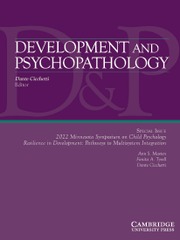Article contents
Self/other organization in human psychological development
Published online by Cambridge University Press: 01 December 1997
Abstract
Evidence from the evolution of human cultural behavior and learning, embryology andgenetics of the brain, and the behavior of human infants indicates that the critical and uniquelyhuman motives for cooperative imagination and joint interest in objects and tasks are determinedby expression of genes and epigenetic neural systems elaboration long before birth, along withessential peripheral organs of perception and motor expression that will serve in communicationby rhythmic facial, vocal, gestural, and body movement signals. These cerebral motives continueto exercise their influence on neural development and behavior throughout life, transforming thebehaviors of the developing individual through a succession of phases to which other individualsand cultural institutions are constrained to adapt. We discuss the theory of innate intersubjectivityand relate it to the hypothesis of an Innate Motive Formation that emerges in brain developmentas regulator of morphogenesis in neural systems, and that continues to function, postnatally, asgenerator of motives and emotions by which human contacts and relationships are regulated. Wesuggest that differentiates of the primary motive formation in the embryo brain later serve togenerate intelligent exploration of the objective environment, and the emergence of an additionaldialogic mechanism that represents the self-subject as a partner for an other-subject,intersubjectively. Intersubjective communication in infancy leads, through systematic age-relatedtransformations of the brain and behavior, to preverbal mimetic negotiation of cooperativeawareness and joint task performance. Finally we discuss, in relation to this theory,interpretations of faulty communication and development at different stages of the life cycle thatresult from maternal postnatal depression, autism, premature birth, and schizophrenia.
Information
- Type
- Research Article
- Information
- Copyright
- © 1997 Cambridge University Press
- 119
- Cited by

